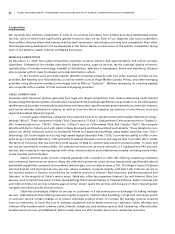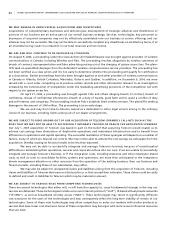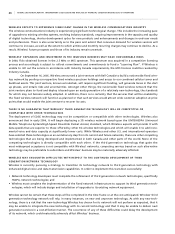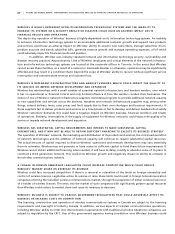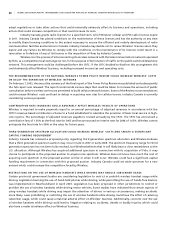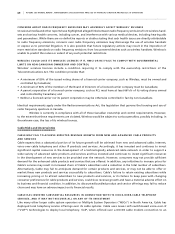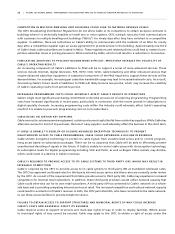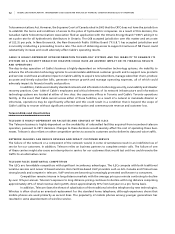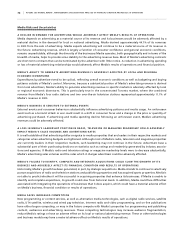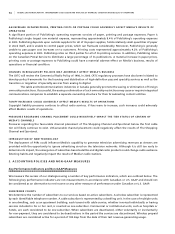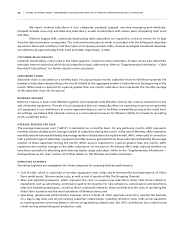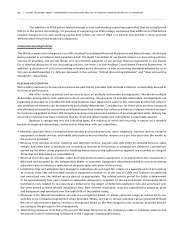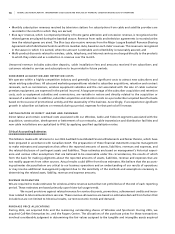Rogers 2005 Annual Report Download - page 73
Download and view the complete annual report
Please find page 73 of the 2005 Rogers annual report below. You can navigate through the pages in the report by either clicking on the pages listed below, or by using the keyword search tool below to find specific information within the annual report.
69 ROGERS 2005 ANNUAL REPORT . MANAGEMENT’S DISCUSSION AND ANALYSIS OF FINANCIAL CONDITION AND RESULTS OF OPERATIONS
CO N C ER N S A BO U T R A DI O F R E QU E NC Y E M I SS I ON S MA Y A D VE R SEL Y A F FE C T W I RE L ES S ’ B U SI N ES S
Occasional media and other reports have highlighted alleged links between radio frequency emissions from wireless hand-
sets and various health concerns, including cancer, and interference with various medical devices, including hearing aids
and pacemakers. While there are no definitive reports or studies stating that such health issues are directly attributable
to radio frequency emissions, concerns over radio frequency emissions may discourage the use of wireless handsets
or expose us to potential litigation. It is also possible that future regulatory actions may result in the imposition of
more restrictive standards on radio frequency emissions from low powered devices such as wireless handsets. Wireless is
unable to predict the nature or extent of any such potential restrictions.
WI R E LE S S C OU L D L O SE IT S WI R EL E SS L IC E NC E S I F I T , R WCI OR RC I FA I LS TO COM P LY WI T H G O VE R NM E N TA L
LI M I TS ON NO N - CA N AD I AN O WN E RS H IP A ND CO N TRO L
Wireless’ wireless licences include a condition requiring it to comply with the ownership restrictions of the
Telecommunications Act. This condition provides that:
• A minimum of 80% of the issued voting shares of a licenced carrier company, such as Wireless, must be owned and
controlled by Canadians;
• A minimum of 80% of the members of the Board of Directors of a licenced carrier company must be Canadians;
• A parent corporation of a licenced carrier company, such as RCI, must have at least 662⁄3% of its voting shares owned
and controlled by Canadians; and
• Neither a licenced carrier nor its parent corporation may be otherwise controlled in fact by non-Canadians.
Identical requirements apply under the Radiocommunications Act, the legislation that governs the licensing and use of
radio frequency spectrum in Canada.
Wireless is currently in compliance with all of these Canadian ownership and control requirements. However,
to the extent that these requirements are violated, Wireless would be subject to various penalties, possibly including, in
the extreme case, the loss of its wireless licences.
Cable Risks and Uncertainties
CA B L E M AY FA I L T O A C HI E V E E XP E CT E D R E VE N UE G RO W TH FRO M N E W A ND A DV A NC E D C A BL E P R O DU C TS
AN D SE R VI C ES
Cable expects that a substantial portion of its future growth will be achieved from new and advanced cable, Internet,
voice-over-cable telephony and other IP products and services. Accordingly, it has invested and continues to invest
significant capital resources in the development of a technologically advanced cable network in order to support a
wide variety of advanced cable products and services and has invested and continues to invest significant resources
in the development of new services to be provided over the network. However, consumers may not provide sufficient
demand for the enhanced cable products and services that are offered. In addition, any initiatives to increase prices for
Cable’s services may result in increased churn of Cable’s subscribers and a reduction in the total number of subscribers.
Alternatively, Cable may fail to anticipate demand for certain products and services, or may not be able to offer or
market these new products and services successfully to subscribers. Cable’s failure to retain existing subscribers while
increasing pricing or to attract subscribers to new products and services, or its failure to keep pace with changing
consumer preferences for cable products and services, could slow revenue growth and have a material adverse effect on
its business and financial condition. In addition, its discounted bundled product and service offerings may fail to reduce
churn and may have an adverse impact on its financial results.
CA B L E H AS IN V E ST E D S UB S T AN T IA L R E S OU R CE S IN CO N NE C TIO N W I TH ITS VO I CE - OVE R -C A BL E TE L EP H ON Y
SE R V IC E S, AN D IT MA Y N O T R E CO V ER A LL OR ANY OF IT S IN V ES T ME N T
Like many other larger cable system operators or Multiple System Operators (“MSOs”) in North America, Cable has
deployed local telephony service offerings over its cable systems. Cable uses newer soft-switch-based voice-over-IP
(“VoIP”) technologies to deploy local telephony. VoIP, when offered over a DOCSIS cable modem connection to an



